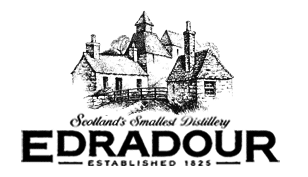Edradour distillery information
The Edradour distillery originally started out as a farm distillery in 1825, established by Alexander Forbes using the name of Glenforres. The name Edradour did not show until around 1837 when a group of local farmers rented land next to the Edradour burn, close to the picturesque town of Pitlochry (which is also home to Blair Athol) from the Duke of Atholl and established the current distillery. The group was led by Mungo Stewart, joined by Duncan Steward, James Scott, and others. In 1841, John McGlashan & Co. (Alexander Forbes, Duncan Stewart, James Scott, James Robertson, Alexander Stewart and William McIntosh) take over the distillery, and from 1853, it is licensed to James Reid and Co.
In 1885, the distillery was taken over by John McIntosh & Co., the son of one of the original founders. McIntosh increased production and turned Edradour into a commericially sustainable distillery. In 1907 he passed away, leaving the distillery to his nephew Peter McIntosh. Peter is joined in 1911 by John Stewart as a partner. Next, in 1923, the distillery is taken over by JG Turney & Son, a subsidiary of American blenders William Whiteley, who are behind the “House of Lords” and “King’s Ransom” blends. With the purchase, they thus ensure themselves of a steady source of whisky.
Subsequent owners
One issue Whiteley had was that at the time, prohibition was still in effect. Whiteley sidestepped that issue by striking a deal with the mob. Following his retirement in 1938, his company and distillery are bought by Irving Haim, who was the American distributor of Whiteley, and who also was an agent for Frank Costello, a notorious mafioso, and the model for the “Godfather” in the movie. Most of the distillery remains as is, with the exception being electricity gets installed in 1947. Haim dies in 1976, and the distillery is subsequently sold to an American/Australian business consortium. In 1982, Edradour is bought by Campbell Distillers, themselves a subsidiary of Pernod Ricard. A new visitor centre is opened in 1983, and the first single malt (a 10 Years Old) is released three years later in 1986.
In 2002, Andrew Symington, owner of Signatory Vintage Ltd buys Edradour, thus returning it to Scottish hands. Ian Henderson, distillery manager at Laphroaig is put in charge of the distillery. The distillery is damaged in August of the same year by a flash flood. 2003 marks the year that Edradour distils an experimental heavily peated expression called Ballechin Heavily Peated. The distillery is refurbished in 2006, and a tasting bar added. A year later, a bottling plant is constructed, and Signatory moves its headquarters on the premises of the distillery. 2009 marks the launch of Caledonia whisky with a 12 Year Old Edradour. Over the next few years, additional buildings are added; a festivities hall as well as a Dunnage warehouse.
Until 2005, Edradour could claim the title of “Smallest distillery in Scotland”. Since 2005 it has to share that with Kilchoman, though currently even smaller distilleries exists (like Daftmill and Strathearn, both of which have expect to distil 20,000 liters per annum (lpa)).
Edradour whisky
Edradour uses Wormtubs to cool the distilled spirit, and it uses a Morton’s Patent Refridgerator, the last one left in Scotland, to cool the worts.
The classic range consists of the following:
- 10 Years Old, Distillery Edition
- 10 Years Old
- 12 Years Old
- Cream liquor
There’s also an “Straight from the Cask” (cask strength) range, with different ages and finished in different casks:
- Bourbon – 10 Years Old
- Sherry – 10 Years Old
- Sherry – 13 Years Old
- Oloroso – 18 Years Old
- Sauternes – 18 Years Old
- Pedro Ximinez – 18 Years Old
Furthermore, extensive experiments have been conducted with different Wine Finishes:
- Barolo – 10 Years Old
- Burgundy – 10 Years Old
- Chateauneuf Du Pape – 10 Years Old
- Chardonnay – 10 Years Old
- Marasala – 10 Years Old
- Fruhburgunder – 11 Years Old
- Spatburgunder – 11 Years Old
- Spatburgunder Cask Strength – 11 Years Old
- Port – 12 Years Old
- Sauternes – 12 Years Old
- Moscatel – 15 Years Old
Unlike the wine finishes range, which consists of whiskies finished in wine casks, there’s also a Wine Matured range, where the whiskies have solely matured in wine casks:
- Burgundy
- Chardonnay
- Ruby Port
- Sauternes
Finally, there’s the Ballechin Heavily Peated range. Ballechin refers to a distillery that operated under that name in the area until 1927. It comes in the following maturation varieties:
- Bordeaux
- Bourbon
- Marasala
- Port
- Sauternes
Distillery info:
| Name | Edradour |
| Region | Highland |
| Logo |  |
| Status | Active |
| Founded | 1825 |
| Water source | Sources from the Moulin Moor |
| Owned by | Andrew Symington |
| Address |
Edradour Distillery |
| Visitor centre | Yes |
| Website | http://www.edradour.com/ |
| N/A | |
| https://www.facebook.com/pages/Edradour-Scotch-Whisky/88589575569 | |
| Community | N/A |
| Map |
Distillery Setup:
Component |
Capacity |
Quantity |
|---|---|---|
| Mash tun | 1.1 tonnes | 1 (Cast iron, with rakes and ploughs, made in 1910) |
| Washback | 5,000 litres | 2 (Douglas Fir) |
| Wash still | 4,200 litres | 1 |
| Spirit Still | 2,000 litres | 1 |
| Expected yearly output in LPA (Litres of pure alcohol) | 90,000 |
